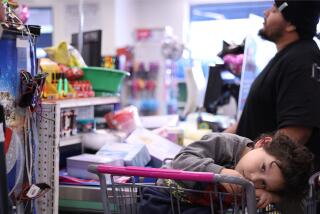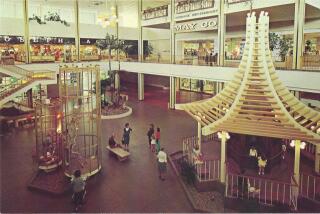Gymboree’s Growth Based on Child’s Play
- Share via
For Joan Barnes, founder of Gymboree recreation centers, the leap from child’s play to retailing was more like a hop.
“It was a natural extension,” says the 41-year-old Mill Valley businesswoman. “The inspiration for the fun and fitness qualities of the apparel came from my experience with the parents and kids at the play centers.”
Since the first Gymboree play center opened in San Mateo in 1976, Barnes has parlayed a belief that children benefit from “purposeful play” into a $14-million annual business--one that includes 18 U.S. children’s stores; more than 350 franchised U.S. recreation programs (nine in the county), Canada, France and Australia, and an extensive line of licensed play equipment.
The exercise-for-tots program was born shortly after the birth of Barnes’ first child. Searching for activities she could share with her infant daughter, the former dance instructor pioneered the 45-minute play sessions. Soon a new center was opening every six months.
The programs of “wee workouts” and “baby boogies,” which cost $4 to $8 a session, succeeded and signaled to Barnes that parents and children were starved for “cooperative, non-competitive and fun play.”
The Burlingame-based Gymboree Corp. opened its first children’s store in 1986, offering bright-colored clothes and play equipment created by in-house designers.
The county stores--in Brea Mall, MainPlace/Santa Ana and South Coast Plaza--are typical of the chain. Building blocks in orange, red, blue and green march up and down the entrance ways. Inside, toys, clothes and Gymbo the Clown, the company’s mascot, help create a feeling of free fun and games.
There are gym-like floors, exercise equipment and videos.
“The parents really are grateful they have a store where they don’t have to tell the kids, ‘Don’t touch,’ ” Barnes says. “It’s like a stop in the park--a refreshing pause along the shopping trail, where they can let their kid out of the stroller for a while.”
Gymboree wear, of soft cotton and flannel, has reinforced knees and stretch cuffs that move with the child’s growth.
Barnes, a mother of two, stresses that the most important thing about the clothes is comfort: “Kids don’t really like being in tight designer jeans. What the consumer wants are clothes suited for kids, not adult clothes scaled down for them.”
In addition to comfortable children’s clothes, what the consumer wants is easy selection, she says, adding that department stores offer too much merchandise that is often out of stock. Barnes has countered with what she calls a “narrow and deep” technique that offers a small selection of “never-out-of-stock” merchandise.
“It’s a matter of narrowing down the consumers’ choices to what we really believe in,” she adds. “People like to have all the pre-selection done for them.”
Barnes describes the typical Gymboree customer as a parent who has brought the child to one of the play centers. “When they hear about the store, they say, ‘Oh, Gymboree, they’re that fun kids’ program.’ And you can see what’s going on in their minds. There’s already a lot of trust there.”
Prices at Gymboree are “somewhere in the middle,” Barnes says. Here are prices on a few items: fleece overalls, $20; long-sleeve baby T-shirt, $12; Gymboree’s At Home Video, $19.95; baby playsuit, $15; suspenders, $7.50. Both the play centers and retail stores are geared to children under the age of 6.
Many Gymboree products are tried out first at the centers, which attract 50,000 children in the United States.
“We have one of the nation’s biggest testing labs,” Barnes says.
More to Read
Inside the business of entertainment
The Wide Shot brings you news, analysis and insights on everything from streaming wars to production — and what it all means for the future.
You may occasionally receive promotional content from the Los Angeles Times.










